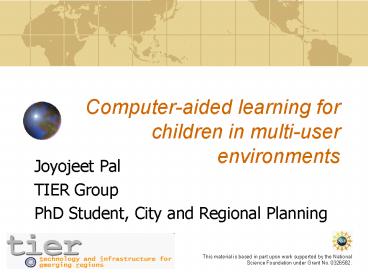Computer-aided learning for children in multi-user environments - PowerPoint PPT Presentation
1 / 14
Title:
Computer-aided learning for children in multi-user environments
Description:
Interviews & Observations of Schools using APF software. Non-random cluster selection of schools ... Child Labour. Landscape. Language ... – PowerPoint PPT presentation
Number of Views:46
Avg rating:3.0/5.0
Title: Computer-aided learning for children in multi-user environments
1
Computer-aided learning for children in
multi-user environments
- Joyojeet Pal
- TIER Group
- PhD Student, City and Regional Planning
2
Field Research May-August 2005
- Interviews Observations of Schools using APF
software - Non-random cluster selection of schools
- Selective recruitment of respondents
- 9 observations
- 130 interviews range 3 min 180 min
- 18 schools
- 15 HTs / HMs
- 28 subject teachers
- 7 computer teachers
- 27 students
- 15 parents
- 4 VEC/Panchayat
- 21 community
- 5 government
- 8 administrators/agency
Children in Cuttack running an OPEPA CD with a
tracing game
3
Socio-economic, project stage variation
4
High school computer center Pondicherry
- This is a computer center from Abishekapakkam in
Pondicherry these typically seat between 3-6
children per PC notice that the teacher has
little involvement in the actual class
functioning. The aggressive users (often
standing) in this case are students from senior
classes sneaking in for extra time
5
Primary school center Mayurbhanj
- In Baripada, Mayurbhanj district in Orissa, the
local school has three computers, to be spread
over 500 students this numerical equation is
not uncommon, consequently, as many as 10
students can be using one computer simultaneously
notice the interactive work here
6
Other Research
- Profiling of
- Parents
- Dropouts
- Headmasters
- Computer teachers
Caste issues, selective education of children
Dropouts are from the poorest families and imp.
wage earners
Headmasters critical for success, but least
invested
7
Observations Social
- Enthusiasm, despite lack of understanding of
computing - Public school demand / Computers vs. English
language - Village community endorsement not adequate
stability indicator - Timetables highly improvisational
- Significant handholding needed from implementing
agency - Likelihood of household spillover impacts of ICTD
(other research substantiates) - High absorption even in highly disadvantaged
settings
8
Observations Curricular
- Teacher Difficulties (and student difficulties,
largely) - English (Pondi, Karnataka)
- Geometry (Orissa, Karnataka)
- Labs
- Student Benefits
- Match concepts fractions / LCM
- Geography (Pondicherry CD popular even in Orissa)
- CALC adaptive, learning pace varies highly
- Reinforcement of classroom standings in CCs
- Children easily tire of narrative content and
want to move to interactive stuff
9
Seating patterns
- No conclusive evidence, but enough to merit
further investigation - Using the ANOVA test for Statistical Significance
we find - The correlation between the position occupied by
the student during the computer class and - the students familys economic position is
statistically significant to over 95.1 - and to a students performance in class is
statistically significant to over 99.8
Seating Position
R2
R1
T
L1
L2
1.50
1.95
2.68
2.00
1.50
Class Performance
1.00
2.24
2.68
2.36
2.00
Economic Affluence
10
Position and Family Affluence
Class Size 21
RIGHT SD0.83
LEFT SD0.66
CENTER SD0.48
11
Position and Classroom Performance
Class Size 21
RIGHT SD0.86
LEFT SD0.82
CENTER SD0.48
12
Shuffling seating
- Children in positions R2 is the smart kid in
class, R1 is average, and C and L1 were among the
poorer performers C being the poorest according
to the teacher. Before the seating intervention,
R2 was the most active, controlling the mouse and
running ahead with the game all the three
remaining were inattentive. There was no dialogue.
13
Future Plans Interaction Design
- Developing regions have unique problem of
multiple-users to a single screen, while most
CALC is designed for single user environments - QUICK FIX RECOMMENDATIONS UNDER CURRENT SYSTEM
- Shuffling students on an experimental basis
- Single set of instructions per active class,
streamlined instead of self-paced - DESIRABLE CURRICULAR CHANGES
- Quick modules that deal with one specific problem
- Intelligent software, adaptive to number of
users, and ability of each user - Split screen options
- Multiple input devices or shared keyboards
14
Thanks
- Sukumar Anikar, Azim Premji Foundation
- Kentaro Toyama, Microsoft Research
- For questions joyojeet_at_berkeley.edu































